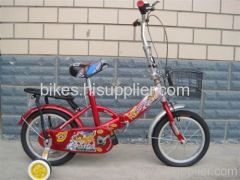
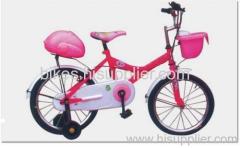
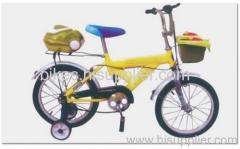
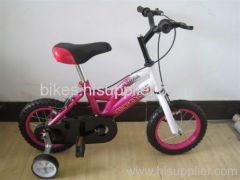
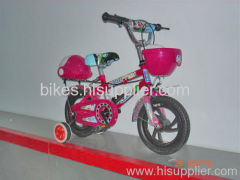
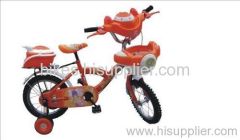
MTB bicycle/BMX bicycle/girl bike,boy bike,kids bike
10.0~20.0 USD
| Min. Order: | 2000 Piece/Pieces |
|---|---|
| Payment Terms: | MTB bicycle, T/T or L/C and so on |
| Supply Ability: | 10000pcs/month |
| Place of Origin: | Hebei |
Company Profile
| Location: | Xingtai, Hebei, China (Mainland) |
|---|---|
| Business Type: | Manufacturer |
Product Detail
| Means of Transport: | by sea |
|---|---|
| Foldable: | No |
| Type: | Mountain Bicycle |
| Frame Material: | Steel |
| Wheel Size: | 18" |
| Brand Name: | mountain bicycle/MTB bicycle/kid's bicycle MTB 12'' 16'' 14'' 18'' 20'' with trading wheel |
| Gross Weight: | 7-20kg |
| packing: | SKD,CKD and so on |
| certificate: | MTB bike ,CCC certificate |
| HS: | 8711901010 |
| Model No.: | children's bicycle *children's bike |
| Color: | to customer's requirement |
| Production Capacity: | 10000pcs/month |
| Packing: | SKD or CKD |
| Delivery Date: | 20-40 days |
Product Description
children's bicycke is very lovely and colourful
Frame:12" STEEL BMX
Fork: STEEL
Rims: STEEL 14G*16H
Tire:12*2.125 black
B)Brand Er long
Kids grow so if they are in a child seat or trailer it won't be long until they outgrow it. At 2-4 years they can move on to their own appropriately sized tri-cycle. On a bicycle, kids can experience/learn the laws of inertia, pedaling, steering, braking and sitting on a saddle. Trikes don't do much to develop a sense of balance and they can be tippy (excluding low-lying "big wheels").
Most kids try a two-wheeler with training wheels around age 3 years.
Between the ages of 4 and 8 years most kids have developed sufficient physical coordination and agility, good balance, and master starting and stopping on a tricycle or training wheels so that they are ready to learn to ride a bicycle. (Note: Kids generally lack the coordination and strength for hand brakes until at least 5.) But, along with physical skills it also takes mental readiness (self-confidence) and motivation to learn to bicycle. Some kids don't develop this until they are 10 or more years old. It sometimes takes a lot of patience on the part of parents. Interest and readiness to learn to ride a bike can manifests itself as questions about bicycles, a desire to ride with friends, talk about tricycles and training wheels as things for "babies," etc. For tips on how to teach a kid to learn to bicycle click on this link.
Guide to Kid Bike Sizes: Children's bike sizes are determined by wheel diameter, not seat height and frame size as is the case with adult bicycles. The chart below should help you narrow your search, but it is not a substitute for an expert helping you find a bike that is most suitable. A critical factor is the brakes. Coaster brakes tend to be easier for young kids to use but they become less common as the bikes get bigger. It can be a conundrum and dangerous when kids who are tall for their age fit bigger bikes with hand brakes that they can't operate well. After kids outgrow children's bikes they'll move into small-framed adult bikes with 26 inch, 27 inch or 700c wheels, which are sized by the length of the seat tube.
| Approximate Age | Child's Inseam | Wheel diameter "bike size" * |
Comments: |
| 2-4 years | 14-17 inches 35-42 cm |
12 inches | Most come with training wheels, some are direct drive |
| 4-6 years | 16-20 inches 40-50 cm |
14 inches | not commonly available |
| 5-8 years | 18-22 inches 45-55 cm |
16 inches | Most have rear coaster breaks and pneumatic tires, some have front hand brakes. |
| 6-9 years | 20-24 inches 50-60 cm |
18 inches | not commonly available |
| 7-10 years | 22-25 inches 55-63 cm |
20 inches | Some models are multi-speed with hand brakes. |
| 9+ years | 24-28 inches 60-72 cm |
24 inches | Can have most of the feature of adult bikes. |
* The size doesn't have any relationship to a real measure: It is certainly not the diameter of the rim. Generally the given size is closer to the tire/tyre diameter from tread-to-tread, but it is usually greater that this distance as well.
Note: the highest rate of bike
Kids grow so if they are in a child seat or trailer it won't be long until they outgrow it. At 2-4 years they can move on to their own appropriately sized tri-cycle. On a bicycle, kids can experience/learn the laws of inertia, pedaling, steering, braking and sitting on a saddle. Trikes don't do much to develop a sense of balance and they can be tippy (excluding low-lying "big wheels").
Most kids try a two-wheeler with training wheels around age 3 years.
Between the ages of 4 and 8 years most kids have developed sufficient physical coordination and agility, good balance, and master starting and stopping on a tricycle or training wheels so that they are ready to learn to ride a bicycle. (Note: Kids generally lack the coordination and strength for hand brakes until at least 5.) But, along with physical skills it also takes mental readiness (self-confidence) and motivation to learn to bicycle. Some kids don't develop this until they are 10 or more years old. It sometimes takes a lot of patience on the part of parents. Interest and readiness to learn to ride a bike can manifests itself as questions about bicycles, a desire to ride with friends, talk about tricycles and training wheels as things for "babies," etc. For tips on how to teach a kid to learn to bicycle click on this link.
Guide to Kid Bike Sizes: Children's bike sizes are determined by wheel diameter, not seat height and frame size as is the case with adult bicycles. The chart below should help you narrow your search, but it is not a substitute for an expert helping you find a bike that is most suitable. A critical factor is the brakes. Coaster brakes tend to be easier for young kids to use but they become less common as the bikes get bigger. It can be a conundrum and dangerous when kids who are tall for their age fit bigger bikes with hand brakes that they can't operate well. After kids outgrow children's bikes they'll move into small-framed adult bikes with 26 inch, 27 inch or 700c wheels, which are sized by the length of the seat tube.
| Approximate Age | Child's Inseam | Wheel diameter "bike size" * |
Comments: |
| 2-4 years | 14-17 inches 35-42 cm |
12 inches | Most come with training wheels, some are direct drive |
| 4-6 years | 16-20 inches 40-50 cm |
14 inches | not commonly available |
| 5-8 years | 18-22 inches 45-55 cm |
16 inches | Most have rear coaster breaks and pneumatic tires, some have front hand brakes. |
| 6-9 years | 20-24 inches 50-60 cm |
18 inches | not commonly available |
| 7-10 years | 22-25 inches 55-63 cm |
20 inches | Some models are multi-speed with hand brakes. |
| 9+ years | 24-28 inches 60-72 cm |
24 inches | Can have most of the feature of adult bikes. |
* The size doesn't have any relationship to a real measure: It is certainly not the diameter of the rim. Generally the given size is closer to the tire/tyre diameter from tread-to-tread, but it is usually greater that this distance as well.
Note: the highest rate of bike

